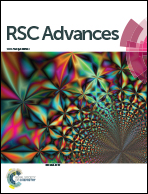In situ growth of MnO2 nanosheets on activated carbon fibers: a low-cost electrode for high performance supercapacitors
Abstract
MnO2 nanosheets were successfully grown in situ on the surface of activated carbon fibers (ACFs) via a facile microwave-assisted hydrothermal method. This environmentally-friendly approach displays the advantages of low temperature, short reaction time and low cost. A series of MnO2/ACFs composites with different MnO2 percentages were prepared and their electrochemical performance as an electrode for supercapacitors was investigated. The 63% MnO2 composite showed the optimal charge storage performance, remarkable rate ability, and excellent cycling capability. The enhanced electrochemical performance is attributed to the combination of good electrical conductivity of ACFs and high capacity of MnO2. This work provides a useful insight into the design and fabrication of hierarchical transition metal oxide and carbon material composite electrodes for potential applications in next generation energy storage systems.


 Please wait while we load your content...
Please wait while we load your content...